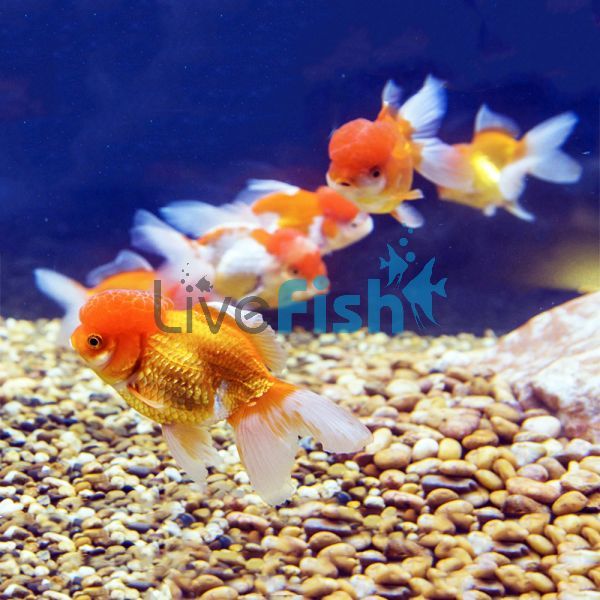Assorted Oranda 18cm
Example Image Only!
Easily one of the most unique goldfish, the Oranda is easily recognized by the bubbly afro it grows on its head and its stubby little body. Specifically bred for many years the adorable Oranda is a staple in the goldfish-keeping hobby and is a must-have in any goldfish community. Their most distinguishing factor is the brain-looking cap they have on their head also referred to as a ‘wen’. These are multiple fluid-filled bubbles that grow naturally on the oranda’s head. They also come in multiple color variants with deep oranges, golds, whites, and blacks meaning that if there are multiple kept together, they can be easily recognized in the aquarium.
Assorted Oranda
Easily one of the most unique goldfish, the Oranda is easily recognized by the bubbly afro it grows on its head and its stubby little body. Specifically bred of many years the adorable Oranda is a staple in the goldfish keeping hobby and is a must-have in any goldfish community. Their most distinguishing factor is the brain-looking cap they have on their head also referred to as a ‘wen’. These are multiple fluid-filled bubbles that grow naturally on the oranda’s head. They also come in multiple color variants with deep oranges, golds, whites, and blacks meaning that if there are multiple kept together, they can be easily recognized in the aquarium. Oranda and goldfish in general are great algae eaters and will make a fantastic addition to outdoor ponds as they will readily graze and eat any algae which can proficiently grow in sunny pond conditions. It isn’t recommended to keep Oranda all year round however in outdoor conditions as they have been bred in tropical conditions, due to their stubby nature, digestion and organ functioning can be compromised in cold environments. Orandas get even better because they are active and personality-filled. Though goldfish is not exactly a great beginner fish due to their size and at times messy habits the oranda is great as it does not get nearly as big in compassion to common goldfish. Those who have proper setups to house these fish are wanting to have some fun or maybe even get their kids more interested in keeping a pet or be more active. The fantails max out at around 15 cm and are actually not found naturally in the wild as they are selectively bred fish for the captive environment.
Tank Recommendations for Oranda goldfish.
The Oranda goldfish can get fairly big at 15 cm. Though 1/3 of this length can be due to the flowing tail fins the fish itself does get the very round meaning that an individual fantail would need around 75 liters (20 gallons) however they are recommended to be kept together with other fancy goldfish. So, when keeping multiple goldfish together a larger tank would be needed. The thing to note however with Oranda goldfish is that though they have stunning fins they are actually not the best swimmers so a slower flow is better. Both in a pond or aquarium, a sand substrate is best as Oranda will actively sift through the sand and smooth river stones can be added for further decoration. Sharp materials should be avoided in the aquarium-like pointy driftwood especially for Oranda because they can easily damage their wen. This can lead to infection and immune-related diseases with the fish.
Suitable Tank Buddies
Oranda is a great fish as they are not aggressive in the slightest and can be kept with tank mates. Common tank mates they can be kept with are active and small coldwater tolerant fish. The goldfish however might eat fry produced by these smaller fish however they will be perfectly fine with adults. Fin nipping species however should be avoided entirely as they will make short work of the flowing fins of the goldfish.
Usually Compatible
Other fancy goldfish species, Medaka ricefish, paradise fish, giant danios, zebra danio, White Cloud Mountain minnows
Sometimes Compatible
Species which can be fin nippers like rosy barbs and also tropical species such as angelfish, dwarf cichlids, mollies, and species of a similar sort. These goldfish can be perfectly kept in tropical water but these tropical fish listed may not have the same habitat requirements as the fantails or may outcompete goldfish. So, it is best to keep them in goldfish-only setups.
Rarely Compatible
Larger cichlids and fish which have a mouth large such as Oscars, jaguar cichlids, and shrimp should also be avoided as fantails will eat shrimp in an instant.
Feeding your Oranda Goldfish
Feeding Oranda should be a breeze, they should immediately take to any aquarium food practically in 24 hours of being added to their new home. Having other Oranda and fancy goldfish tank mates as well will really boost their confidence making them an almost ravenous pack when feeding (all friendly though). Slow-sinking foods would be best as Oranda has been known to at times get swim bladder issues after frantically gulping for food at the surface. Good quality pellets or flakes which are rich in algae or spirulina content are best to suit their herbivorous diet.
| Scientific Name | Carassius auratus |
|---|---|
| Care Level | Easy |
| Common Names | Oranda Goldfish, bubble head goldfish |
| Diet | Herbivore |
| Fish Family | Cyprinidae |
| Lifespan (years) | 15 |
| Max. Length (cm) | 15 |
| Min. Tank Volume (l) | 75 Liters |
| Origin | Asia |
| Reef Safe | No |
| Sociability | Peaceful |
| Venomous | No |
| Water Conditions | 20 -25° C (41 - 77° F), pH 7.0 - 8.5 |




